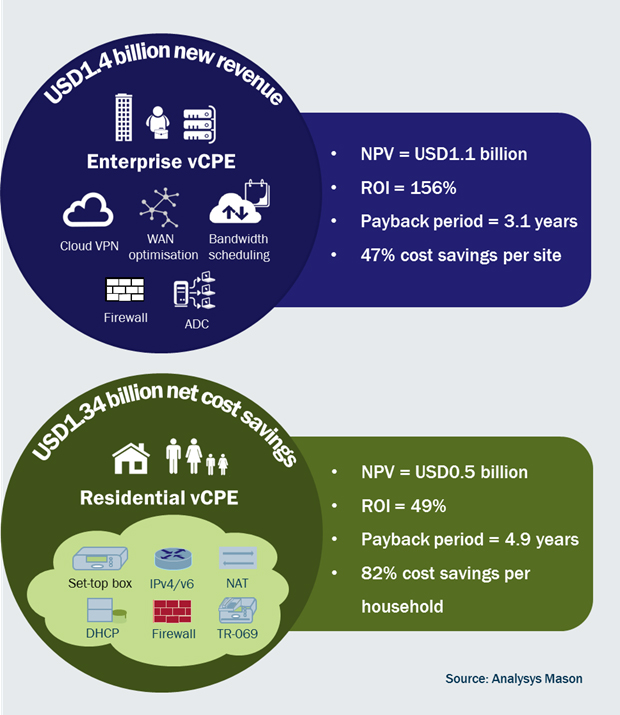As network functions virtualisation (NFV) and software-defined networking (SDN) technologies move from proof of concept to commercial deployment in communications service provide (CSP) networks, business cases are becoming more critical. Analysys Mason and Amdocs recently collaborated on business case models for enterprise and residential virtual CPE (vCPE). The results of these modelling efforts, which were corroborated with CSP interviews, provide important lessons for CSPs considering NFV- and SDN-based service business cases and the vendors that support them.
Benefits will differ depending on the services supported
The general benefits touted for NFV/SDN include lower capex and opex, quicker time to revenue and enablement of new services/exposure to new revenue opportunities. However, the relative impact of these benefits on a NFV/SDN business case will depend on the specifics of the case in point. At the highest level, the type of service the CSP is considering for launch is a significant variable. In our modelling, for example, the results of which are highlighted in Figure 1, the key return on investment (ROI) benefit of deploying vCPE as compared with physical CPE accrued from revenue uplift in the enterprise case and cost savings in the residential case.

For enterprise vCPE, cost savings did accrue, compared with the status quo, from a combination of simpler CPE based on reusable, commercial-off-the-shelf (COTS) servers; automated delivery of on-net services; and quicker, remote resolution of faults. However, the more significant ROI benefit was revenue uplift from:
- upsell from customer self-service
- quicker time to revenue from dynamic VPN and WAN configuration
- broader availability of data centre interconnect services (e.g., load balancing, bandwidth calendaring and BoD)
- security as a service (e.g., firewall) and other add-on enhancements including caching and WAN optimisation
The caveat? The revenue benefits will be much better for those CSPs who move fast and are able to differentiate and hold prices steady while enjoying the cost benefits of virtualisation.
For residential vCPE, our model also predicted upsell opportunities (e.g., of customers moving from double- to triple-play bundles), but these revenue benefits were dwarfed by cost-reduction benefits. The cost reduction accrued from a similar combination of factors as those in the enterprise case (simpler, more programmable CPE, shorter time between service order and delivery, and quicker and better fault resolution), but the impact of the cost reductions was far greater: 82% in the residential case as compared to 47% in the enterprise case.
Refining the business case
Most NFV/SDN business cases that we’ve seen or talked through with CSPs are based on specific service launches. End-to-end modelling, as Analysys Mason has done with the vCPE cases, that includes all relevant hardware, software (VNF, management, and orchestration software and related operational support systems) and transformation costs—not just the VNFs that might be replacing physical appliances—is critical. Vendors will refine their payment models as they move from up-front capex models to pay-as-you-go opex consumption models, allowing business case modellers to improve product-related cost accuracy. Finally, our talks with NFV/SDN CSP first movers suggest that capturing the full revenue benefits will require refining the sales process to establish best practices in structuring the virtualisation-based service offers and selling their benefits.
The author of this blog is Dana Cooperson, head of networks-focused software systems research at Analysys Mason






